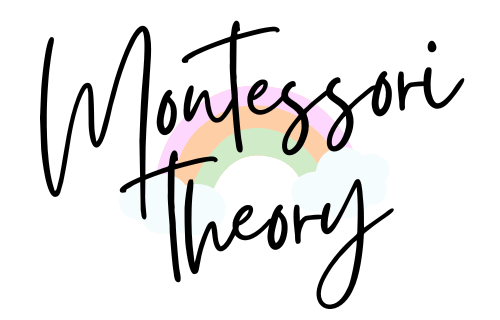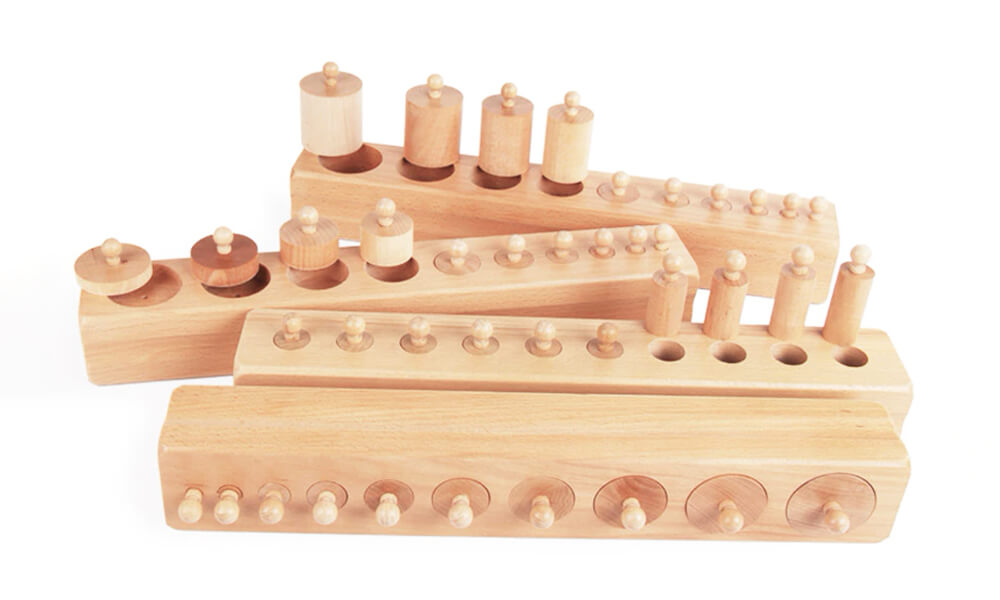Montessori education is based on the principle that children learn best through hands-on, sensory experiences. One of the key materials used in Montessori classrooms to provide these experiences is the knobbed cylinder. In this blog post, we’ll explore the presentation, purpose, benefits, and age-appropriate use of knobbed cylinders in Montessori learning material.
What are Montessori Knobbed Cylinders?
Montessori knobbed cylinders are designed to help children learn about shapes, sizes and spatial relationships. They come in varying heights, length and diameters so that users can explore the different combinations of these elements. With each cylinder comes an exercise or game to achieve, which helps to develop visual-spatial skills as well as eye-hand coordination. While playing with Montessori knobbed cylinders may seem like a simple task at first glance, it is actually a great way to encourage learning in new ways.
These wooden pieces are perfect for promoting visual perception and learning in young children. They can also help with problem-solving, hand-eye coordination and fine motor development. Not only do they offer a unique tactile experience, but they also provide a fun way to explore mathematical concepts.
Montessori Knobbed Cylinders Material
Montessori knobbed cylinders set includes four wooden blocks with a light varnish finish, each containing ten cylinders of varying sizes in a regular pattern. Each cylinder has a wooden knob for easy handling. The cylinders and their corresponding wells vary in diameter and/or height, with the dimensions ranging from 5.5 cm to 1.0 cm, in increments of 0.5 cm.
- Block 1 has cylinders that are all 2.5 cm in diameter and only vary in height. The difference in height between any two consecutive cylinders is 0.5 cm.
- Block 2 has cylinders that decrease in diameter while maintaining a height of 5.5 cm. The height of all cylinders is the same, but their length and width (measured by diameter) differ by 0.5 cm between each consecutive cylinder.
- Block 3 has cylinders that decrease in both diameter and height. The height, length, and diameter of the cylinders vary by 0.5 cm between each consecutive cylinder. The largest cylinder is both the tallest and thickest.
- Block 4 has cylinders that increase in height while decreasing in diameter. The tallest cylinder is now the thinnest and the shortest cylinder are now the thickest.
Montessori Knobbed Cylinders Purpose
The child learns a variety of skills through playing with the wooden blocks and cylinders. They learn to judge size by sight, develop an understanding of dimension and observe the environment with more intelligence. The child also develops coordination of movement through manipulating the wooden knobs.
Additionally, the child is given indirect preparation for writing as their fingers and thumb are used to hold the knobs, training them for manipulative skills that will be useful in the future when using tools like a spoon, scissors, or brush. In addition, by observing the regular differences between the cylinders, children are also prepared for mathematical concepts such as measuring and comparing sizes.
Montessori Knobbed Cylinders Benefits?
The Montessori method is a child-centered approach to education that emphasizes the importance of hands-on learning. Through the use of Montessori materials such as the knobbed cylinders, children are able to explore and discover new concepts in a way that is natural and engaging for them. These wooden cylinders, developed by Dr. Maria Montessori in the early 1900s, have long been a source of fascination for educators and parents alike.
Using knobbed cylinders in a Montessori environment can provide a variety of benefits for children.
These benefits include:
- Developing the child’s visual discrimination of size by working with the cylinders of varying diameter and height.
- Indirectly preparing the child for writing through the handling of the cylinders by their knobs, which helps develop a pincer grasp.
- Indirectly preparing the child for later work in mathematics through observation of the regular differences in the cylinders, and learning about size, measurement, and proportion.
- The use of the knobbed cylinders and blocks promote fine motor skills, hand-eye coordination, and concentration.
- The child also learns about classification, organization and sequence as they sort and arrange the cylinders in the correct blocks.
Montessori Knobbed Cylinder Lessons & Exercises?
The Knobbed Cylinders play a vital role in preparing children for writing. By working with the cylinders at a table instead of on a rug or mat, children learn to sit in a comfortable and proper position. This, along with using a pincer grasp on the knobs of the cylinders, which is similar to holding a pencil, is an indirect way to prepare the child for writing. The Montessori method emphasizes the importance of using these sensorial materials to develop a child’s hand-eye coordination and fine motor skills, which are essential for writing.
- Introduce the Cylinder Blocks by naming them and pointing out where they are stored. Carefully pick up Cylinder Block 1, emphasizing the importance of holding it securely by grasping each end with their hands. Gently place the block on a table, taking care not to make any noise or disturbance. Place the block without using any table mat, so that the child can hear and feel the difference.
- Take out the cylinders in a random order, lifting each one by its knob, using your thumb, index finger and middle finger (the same fingers used for writing with a pencil) to hold it. Gently and quietly place each cylinder upright on the table surface, between you and the block, in a random arrangement. Be sure to place each cylinder down gently, ensuring that no sound is made as it touches the table top. Once all the cylinders have been removed, pause and take a moment to examine the ten mixed-up cylinders standing on the table with the child.
- Choose either the thickest or thinnest cylinder, lift it by its knob, and make a visual assessment of which well it would fit into without comparing it to the other wells. Carefully place this cylinder in the appropriate well in one smooth movement, making sure that the cylinder does not knock against the edge or sides of the well and there is no noise as it touches the bottom. Repeat this process with the other extreme thickness or thinness cylinder. Continue in a random order, placing each cylinder in its correct well. Pause occasionally to visually determine which cylinder belongs in which well, without physically comparing them. Keep doing this until all the cylinders are returned to the block. Allow the child to have a turn.
As children continue to work with the wooden blocks and cylinders, they will have the opportunity to move on to more challenging exercises. These exercises will continue to develop their understanding of size, dimension and coordination, as well as their manipulative skills. With practice and patience, children will be able to master the more complex tasks.
It is important not to rush the children through the different stages of using the wooden blocks and cylinders. Introduce the final stages only when they have fully mastered working with the four blocks individually. The aim is not to get the children to work quickly, but to allow them to work with the apparatus for as long as it takes to master it and reach a deeper understanding. This principle applies to all devices and activities used in the learning process.
- Once the child has mastered working with a single set of wooden blocks and cylinders, they can be shown how to use two sets together by mixing the cylinders from both and replacing them.
- When the child has become proficient in using two sets, the teacher can introduce the next level of difficulty by demonstrating how to take three sets, arrange them in a triangle shape on the table, mix the cylinders in the middle of the triangle, and then replace them in their corresponding sockets.
- Finally, the child can be challenged with the most advanced level of difficulty by showing them how to use all four sets together by arranging them on the table in the form of a square, mixing all the cylinders inside the square, and then replacing them in their corresponding sockets.




